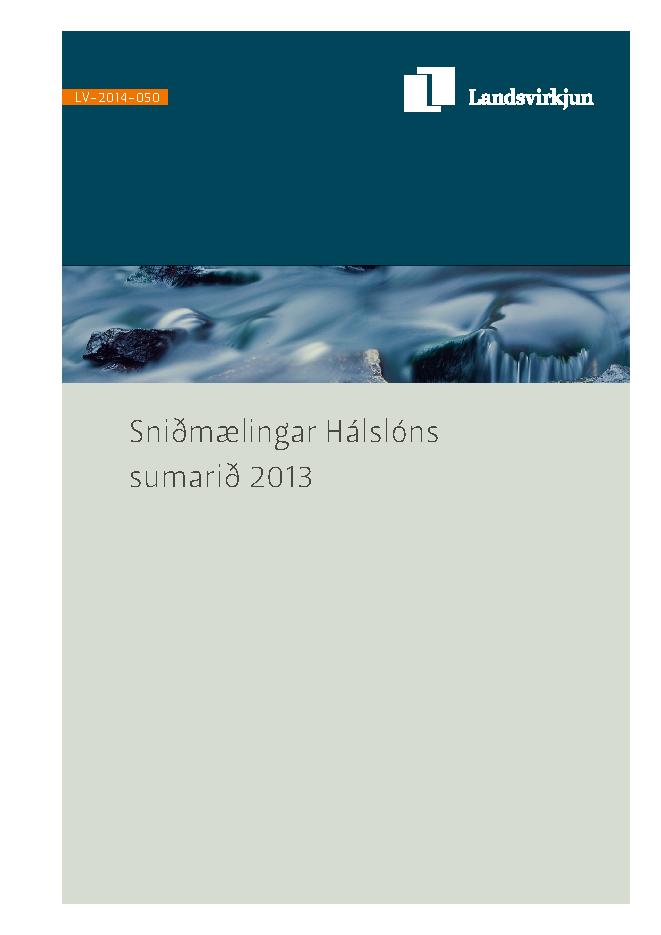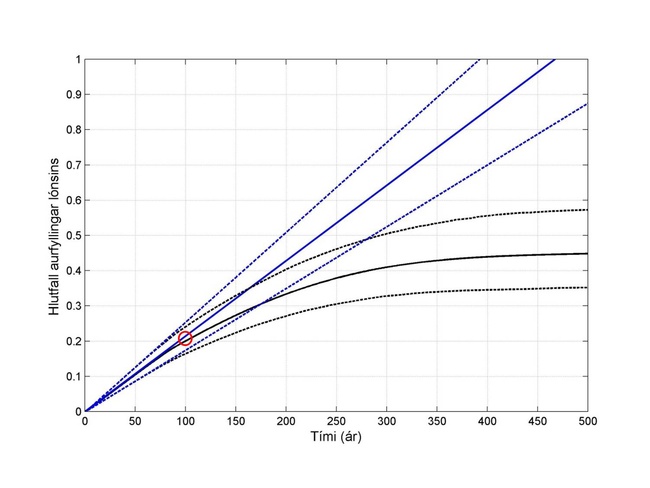Progress
The research division of Landsvirkjun (National Power Company of Iceland) measured the depth of the Hálslón reservoir in the summer of 2013 with advanced multibeam echosounder a) to get an estimate on the volume and volume changes since Hálslón was first created. Based on the results of measurements the total capacity of the reservoir is estimated 2447 Gl and flood control capacity to 2195 Gl.
The measurement also confirms previous findings about the size of the reservoir, nearly 62 km2.
The result is interesting in the sense that the evaluation of the capacity of the reservoir increases year by year, or about 128 Gl. The main part of the expansion of the reservoir is caused by retreat in the tail of Brúarjökull and the capacity increase is mainly in the upper part of the reservoir (> 600 m). Tail of Brúarjökull is now about 4.3 km higher than in 2008. Hálslón is about 28 km long and 3 km wide.
a: http://en.wikipedia.org/wiki/Multibeam_echosounder
Updated: April 26, 2014
Source: Landsvirkjun (2014).
Metrics, Targets and Monitoring Protocol
What is measured?
Volume (m3) of delta formation every 10 years. (Project effect: direct).
Monitoring Protocol
Bathymetric survey of reservoir every 10-20 years.
The present map of the reservoir basin is based on land measurements and a model which cannot be repeated. The first measurement after the power station has been started is done with some kind of a bathymetric tool, and will be considered as a baseline measurement. It is considered appropriate to perform it around 10 years after the reservoir starts to fill up.
The first measurement will take place 10 years after the baseline measurement and will then reach 2 km north of the confluence of Kringilsá river.
Another measurement, 10 years later, will cover the whole reservoir basin.
While the sediment deltas, where the main river forks enter the reservoir, will be measured every 10 years, the reservoir on the whole will be measured every 20 years.
Target/Expectations
Usable storage will not decrease more than 20-25% during one century.
The ideas presented in the Environmental Impact Assessment (EIA) assumed that all the sediment of the glacial river would settle in Hálslón Reservoir. The simulation model made by Vatnaskil (see here, only in Icelandic) estimates how the sediment deltas will develop into Hálslón in the next decades. Measurements of the base layer of Brúarjökull clacier, performed by the Science Institute of the University of Iceland, show that there is a deep valley under the glacier. If global warming continues - as predicted - and Brúarjökull glacier will regress (as expected), this valley will turn into a deep glacier lagoon, like Jökulsár Lagoon. This lagoon will collect the main part of the sediment instead of Hálslón reservoir (Sigurdur M. Gardarsson et al. 2006).
Two case scenarios:
According to the predicted development above, Gardarsson et al. consider it highly likely that Hálslón reservoir will not be filled with sediment until about 10,000 years after its birth. In the graph below from Gunnarsson et al., the blue lines shows the development of filling according to the unchanged size of Brúarjökull glacier. The black line shows the probable filling process according to present forecasts on global warming and the retreat of the glacier. It would not change much in the next 100 years - and by then the reservoir would have shrunk by one-fifth, as assumed. The red circle shows the situation in 100 years.
Vertical axis= percentage of filling in Hálslón reservoir, horizontal axis = time (years).
Figure 1. Forecast of the development of the Hálslón reservoir based on the unchanged size of Brúarjökull (blue curve) and warming and retreat of the glacier according to forecasts (black curve)
Possible countermeasures
Not applicable, monitoring only.
Changes of indicator
This indicator was originally number 19.1. It was then named Sediment deposition in Hálslón Reservoir and can be found under that number in documents of the project from 2005 and 2006.
The indicator number has been changed twice.
| Year | Nr. | Indicator name |
|---|---|---|
| 2020 | 2.2.3 | Sediment deposition in Hálslón |
| 2007 | 2.5 | Sediment Deposition in Hálslón Reservoir |
Baseline
The land forming the bottom of Hálslón reservoir has been mapped, both the vegetation and the geology, as well as the fauna and archeological remains. Sedimentary deposits from the end of the ice age have also been researched, with other geological issues.
The sediment load of Jökulsá in Dal river has been monitored from 1964 when the National Energy Authority started measurements of sediment in the river water. Monitoring of bed load has been ongoing for a few years, the last ones being from 2001. Models have been made to predict sedimentation and grain size gradient in the Reservoir. See report from Vatnaskil Engineering (2005).
Rationale for Indicator Selection
Sediment deposition in Hálslón Reservoir will influence how long the power plant will be in operation and is therefore an important sustainability issue. The construction of Kárahnjúkar Power Plant created Hálslón reservoir. When the reservoir is full (that is, with a fillling above the overflow heigh in 625 m over sea level), its square measure is around 61 km2. At the start, the reservoir was expected to be around 57 km2. The increased size is partly because of the fact that the Brúarjökull glacier tongue has moved inwards. Hálsón is approximately 24 km long and 3 km wide at maximum lake level. Total storage in the reservoir is around 2340 gigaliters, with usable storage around 2100 gigaliters.
The sediment load of Jökulsá in Dal and Jökulsá on Fjöllum are the highest of all Icelandic rivers estimated conservatively as 6.5-7.0 million tons on average per year of which 90 percent is suspended load and around 10 percent bed load. Most of this sediment, around 5.5-6.0 million tons per year, will settle in the reservoir and, according to models, the reservoir will fill up in a few centuries provided there will be no significant changes in the Vatnajökull glacier. Earlier estimates assumed this to be around 7-8 million tons. The review of the sediment load is based on better sampling methods (see Further reading). The sedimentation will be mainly at the top end of the reservoir where deltas will form where the river Jökulsá issues into it. In around 25 years, these deltas could extend some 1.5 km into the reservoir and after 100 years the delta could extend about 6 km into the reservoir.
The annual sedimentation in Hálslón reservoir equals to the cubic measure of a pyramid 250 m in diameter and 240 m high. It is estimated that the Keops pyramid in Egypt was originally aroun 230 m in diameter and 146.5 m heigh. The Keops pyramid is the largest one that the pharaoh Khufu had build.
Updated: April 26, 2014
Source: Landsvirkjun (2014)
Original Rationale for Indicator Selection
Sediment deposition in Halslon Reservoir can influence how long the power plant will be in operation and is therefore an important sustainability issue. The construction of the Kárahnjúkar power plant will create the 57 km2 Halslon Reservoir. The reservoir will be around 24 km long and less than 3 km wide in most places. Total storage in the reservoir will be around 2340 gigaliters, with usable storage around 2100 gigaliters.
The sediment transport of Jokulsá in Dal is the highest of all Icelandic rivers estimated conservatively as 7 – 8 million tons per year of which 90 percent is suspended load and around 10 percent bed load. Most of this sediment, around 6.5 – 7.0 million tons per year, will settle in the reservoir and, according to models, the reservoir will fill up in a few centuries.
The sedimentation will be mainly at the top end of the reservoir where a delta will form where the river Jokulsá in Dal runs into it. In around 25 years, these deltas will extend some 1.5 km into the reservoir and after 100 years the delta will extend about 6 km into the reservoir.
From phase I/II report on indicators and baseline from April 2005
Further reading

LV-2014/050 - Sniðmælingar Hálslóns sumarið 2013
You can view more material related to the indicator by clicking on the link above.

